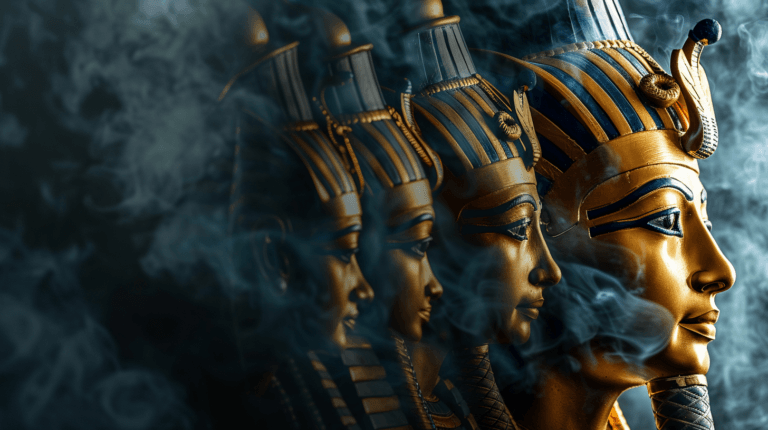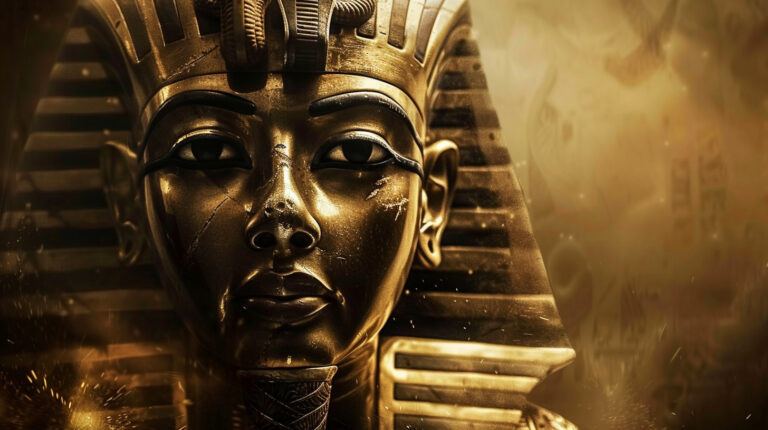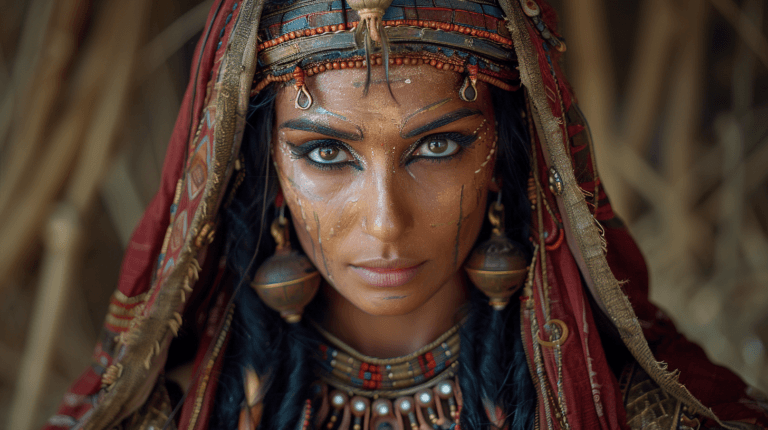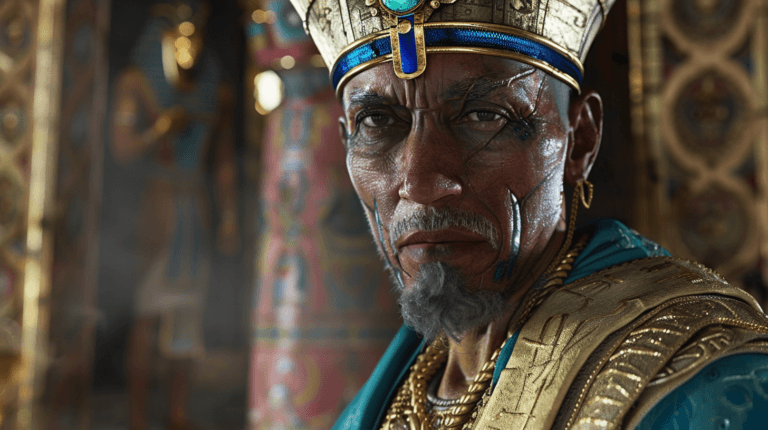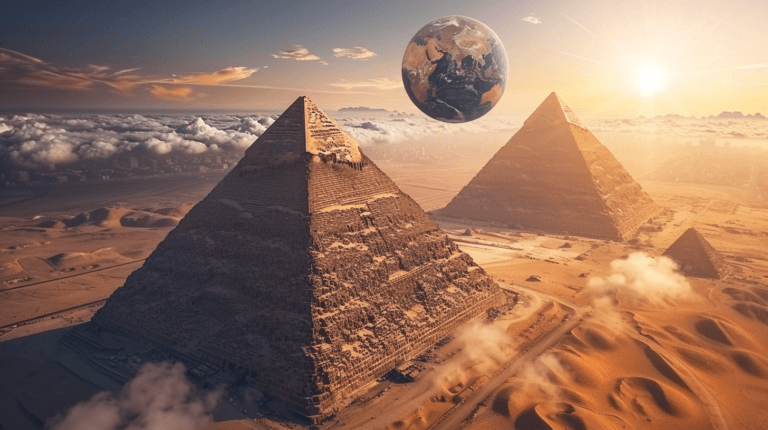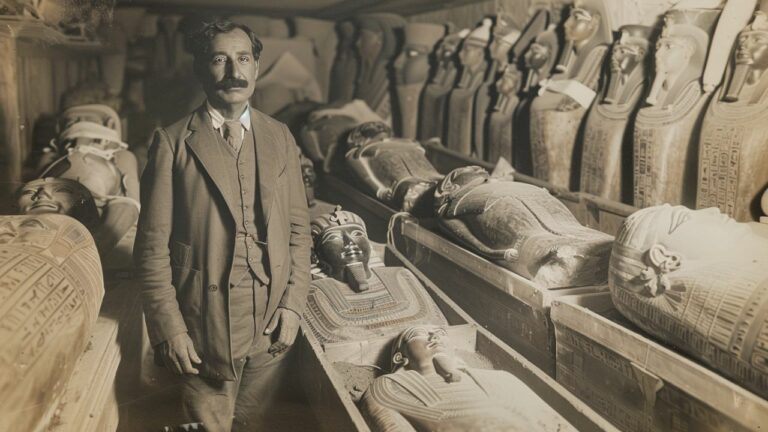Hatshepsut Female Pharaoh – Discover Her Legacy
Did you know that one of the most powerful rulers of ancient Egypt was a woman? Meet the remarkable Hatshepsut female pharaoh who defied societal norms and left a lasting legacy in the annals of history. Born in 1507 BCE, Hatshepsut rose to become the fifth Pharaoh of the Eighteenth Dynasty of Egypt, breaking barriers and proving that women could thrive in positions of leadership.
During her reign, Hatshepsut brought prosperity and stability to Egypt, setting the stage for cultural development and architectural marvels. Her story is a testament to the potential of women in power and serves as an inspiration for generations to come.

Key Takeaways:
- Hatshepsut was a powerful female ruler in ancient Egypt, defying societal norms.
- She brought prosperity and stability to Egypt during her reign.
- Hatshepsut left behind a legacy of architectural marvels and artistic achievements.
- Her reign showcased the potential of women in leadership roles.
- Hatshepsut’s story continues to inspire and intrigue people to this day.
Rise of a Queen to Pharaoh’s Throne
From her birth, Hatshepsut was destined for greatness, born into the royal heritage of Ancient Egypt. In 1507 BCE, she entered the world as the daughter of Pharaoh Thutmose I and Queen Ahmose.
As she grew older, Hatshepsut’s path to the pharaoh’s throne took an unexpected turn. She married her half-brother, Thutmose II, who would later ascend to the throne after their father’s demise. This marriage solidified her position within the royal family and set the stage for her future rise to power.
Initially, Hatshepsut’s role was that of a regent, assuming the responsibility of guiding her stepson, Thutmose III, who became pharaoh at a tender age. However, Hatshepsut’s ambitions and determination soon led her to assert her authority and rightful place as co-ruler alongside Thutmose III.
Asserting her authority as a pharaoh, Hatshepsut adopted the full royal titulary and presented herself as a legitimate ruler in her own right. Taking on the regnal name Maat-ka-re, meaning “The true one of the Ka of Re,” she emphasized her divine connection to the gods and solidified her reign as a pharaoh.
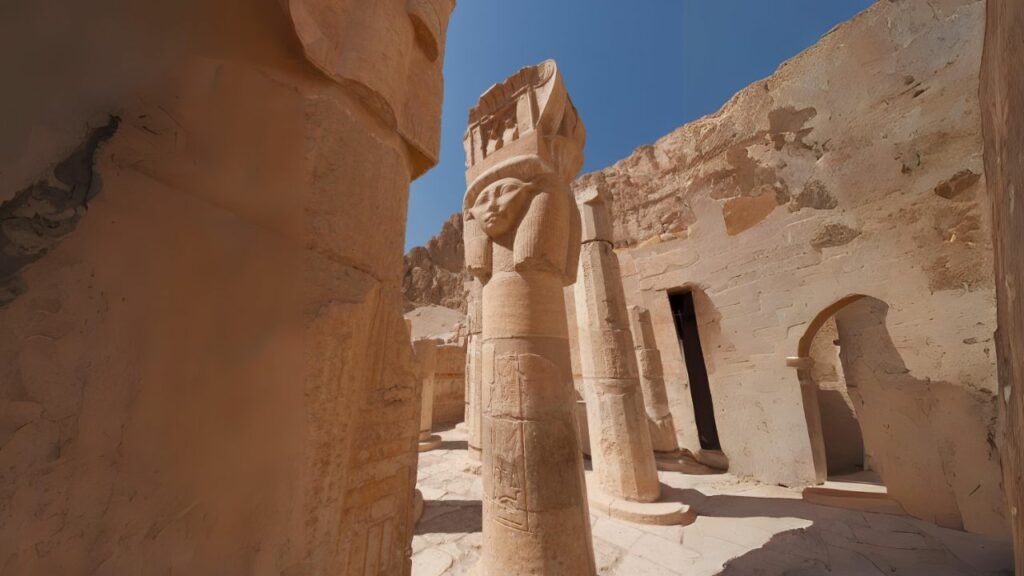
Birth and Royal Heritage
Hatshepsut’s birth into the royal family of Ancient Egypt provided her with the legitimacy and authority required to ascend to the pharaoh’s throne. She was destined to become a powerful ruler, shaping the history of the ancient civilization.
Marriage to Thutmose II and Path to Co-Regency
By marrying her half-brother, Thutmose II, Hatshepsut secured her place within the royal lineage. With Thutmose II’s subsequent ascension to the pharaoh’s throne, Hatshepsut’s path to power became even more apparent. Her marriage not only solidified her position but also set the stage for her to assert her authority.
Asserting Authority: Hatshepsut as Co-Ruler
Hatshepsut’s determination and drive to assert her authority led her to challenge the gender norms of Ancient Egyptian society. By presenting herself as a co-ruler alongside Thutmose III, she exhibited her strong will and ambition. Through adopting the regnal name Maat-ka-re, she asserted her divine right to rule and demonstrated her capability as a pharaoh.
Hatshepsut Female Pharaoh: A Reign of Prosperity
Hatshepsut’s reign as the female pharaoh of Ancient Egypt brought about a period of unprecedented prosperity and stability. Under her rule, Egypt experienced remarkable economic growth, expanded trade networks, and increased wealth.
To fuel economic prosperity, Hatshepsut sponsored numerous successful trading expeditions, notably to the Land of Punt. These expeditions brought back valuable resources such as gold, ebony, and incense, further enriching Egypt and fueling its economic success.
In addition to fostering economic growth, Hatshepsut implemented policies that promoted agricultural development. These policies led to increased food production, improved living conditions, and a higher standard of living for the people of Egypt.
Importantly, Hatshepsut’s reign was characterized by peace and cultural flourishing. She placed a strong emphasis on promoting the arts, architecture, and religious practices, resulting in a vibrant and prosperous society.
To appreciate the grandeur and opulence of Hatshepsut’s reign, one must marvel at the incredible architectural achievements of the time. From the magnificent Mortuary Temple of Hatshepsut at Deir el-Bahari, with its impressive, terraced structure and intricate reliefs, to the colossal obelisks at Karnak Temple, Hatshepsut’s architectural legacy stands as a testament to her power and wealth.
Overall, Hatshepsut’s reign as a female pharaoh left an indelible mark on the history of Ancient Egypt. Through her leadership, the country experienced an unprecedented era of prosperity and stability, firmly establishing her as one of the most influential rulers of the time.
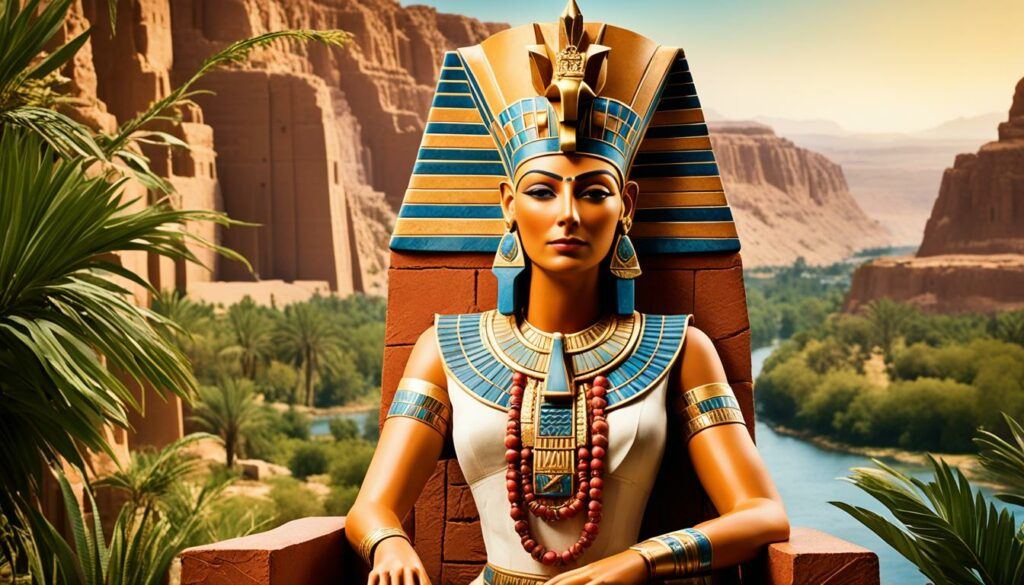
Architectural Marvels and Reestablished Trade Networks
Hatshepsut, known for her visionary leadership, oversaw the construction of several extraordinary architectural marvels, leaving an indelible mark on ancient Egypt. Her reign witnessed the revival of trade networks and the exploration of new lands. Let’s delve into these remarkable achievements.
Voyage to the Land of Punt
One of Hatshepsut’s notable accomplishments was the successful voyages to the Land of Punt. Located in present-day Somalia, Punt was a mysterious and wealthy region known for its precious resources, including gold, ivory, and frankincense. These expeditions had a two-fold purpose – to reestablish trade networks and secure valuable commodities for Egypt.
Imagine Hatshepsut’s fleet of beautifully adorned ships setting sail across the vast waters of the Red Sea, laden with goods and gifts. This trade mission helped Egypt to obtain rare and exotic materials, enhancing the wealth and prestige of the empire.
Building the Magnificent Deir el-Bahari
Hatshepsut’s grand endeavor to immortalize her reign can be witnessed in the construction of the breathtaking Mortuary Temple of Hatshepsut at Deir el-Bahari. Situated on the west bank of the Nile, this temple is a testament to her architectural genius.
The temple’s terraced design, spanning three levels, harmonizes seamlessly with the natural rock formations, creating a visually striking monument. The intricate reliefs adorning the walls tell the story of Hatshepsut’s reign, highlighting her political achievements, religious devotion, and the voyages to the Land of Punt. The temple’s beauty and artistry continue to captivate visitors to this day.
The Colossal Obelisks of Karnak
An enduring symbol of power and grandeur, the colossal obelisks constructed by Hatshepsut at Karnak Temple are awe-inspiring. Each obelisk stands tall, reaching towards the heavens, adorned with intricate hieroglyphic inscriptions.
The construction of these obelisks not only showcased Hatshepsut’s wealth and authority but also added to the magnificence of the Karnak complex. These towering structures, crafted from a single piece of granite, exemplify the mastery of ancient Egyptian stonemasonry. Even today, they stand as a testament to Hatshepsut’s enduring legacy.
Hatshepsut’s architectural marvels and the reestablished trade networks she fostered contributed to the prosperity and cultural development of ancient Egypt. Her legacy continues to inspire awe and admiration, a testament to the exceptional leadership and vision of this remarkable female pharaoh.
Hatshepsut’s Artistic Legacy and Depiction of Power
In addition to her architectural achievements, Hatshepsut’s artistic legacy is another testament to her power and authority as a female pharaoh in ancient Egypt. Through unique statues and depictions, she solidified her position as a formidable ruler, leaving an indelible mark on history.
The Statuary: Feminine Pharaoh with a Beard
A remarkable aspect of Hatshepsut’s artistic representations is her portrayal as a feminine pharaoh with masculine features, including a beard. This unconventional depiction served to assert her legitimacy as a ruler and challenge traditional gender roles of the time. By melding feminine and masculine attributes, Hatshepsut presented herself as a strong and capable leader, garnering respect and emphasizing her undeniable power.
Religious and Cultural Innovations
Hatshepsut’s artistic contributions extended beyond mere representation. She introduced religious and cultural innovations that had a profound impact on Egyptian society. Notably, she promoted the worship of Amun, a significant deity in the Egyptian pantheon. By elevating the status of Amun, Hatshepsut solidified her connection to the gods and bolstered her religious authority.
Furthermore, Hatshepsut played a crucial role in elevating the position of female deities in Egyptian religious practices. Through her patronage, female gods such as Hathor and Isis gained prominence, leading to a reimagining of the divine feminine and a more inclusive religious landscape.
This artistic and religious revolution spearheaded by Hatshepsut left an enduring impact on Egyptian art and culture. Her depictions as a powerful feminine ruler and her religious innovations influenced future generations of artists and rulers, shaping the artistic landscape and cultural achievements of ancient Egypt for centuries to come.
Conclusion
Hatshepsut’s reign as a female pharaoh in Ancient Egypt was an extraordinary era of prosperity and cultural development. She defied societal norms and established herself as a powerful ruler, leaving behind a lasting legacy of architectural marvels, artistic achievements, and religious innovations.
Her reign stands as a testament to the potential of women in leadership roles and serves as a symbol of female empowerment in ancient history. Hatshepsut’s rule continues to inspire and intrigue people to this day, as her remarkable achievements have left an indelible mark on the history of Ancient Egypt.
Through her ambitious architectural projects and successful trade ventures, Hatshepsut brought wealth and stability to Egypt. Her reign was characterized by economic growth, expanded trade networks, and increased cultural flourishing. From the voyages to the Land of Punt to the construction of the magnificent Mortuary Temple at Deir el-Bahari, her accomplishments showcase her power, wealth, and commitment to the prosperity of her kingdom.
Furthermore, Hatshepsut’s artistic legacy is a testament to her immense influence. She was often depicted as a feminine pharaoh with masculine features, emphasizing her authority and legitimacy. Her introduction of religious and cultural innovations further solidified her status as a revered ruler. From her connection to the gods to her elevation of female deities, Hatshepsut’s artistic and religious contributions continue to shape and inspire Egyptian art and culture.
FAQ
Who was Hatshepsut?
Hatshepsut was a powerful female pharaoh who ruled Egypt during the Eighteenth Dynasty of Ancient Egypt. She defied societal norms in ancient Egypt by ascending to the throne, a position traditionally reserved for men.
When was Hatshepsut born?
Hatshepsut was born in 1507 BCE to Pharaoh Thutmose I and Queen Ahmose, making her a member of the royal family.
How did Hatshepsut become a pharaoh?
Hatshepsut initially served as regent to her stepson, Thutmose III, who became pharaoh at a young age. Over time, she asserted her authority and took on the role of co-ruler alongside Thutmose III, adopting the full royal titulary and presenting herself as a legitimate pharaoh.
What were some of Hatshepsut’s accomplishments as pharaoh?
During her reign, Hatshepsut brought prosperity and stability to Egypt. She implemented policies that promoted agricultural development, leading to increased food production and improved living conditions. She also sponsored successful trading expeditions, such as the voyage to the Land of Punt, which reestablished trade networks and brought back valuable resources.
What architectural marvels were constructed during Hatshepsut’s reign?
Hatshepsut oversaw the construction of several impressive structures, including the Mortuary Temple of Hatshepsut at Deir el-Bahari, known for its terraced structure and intricate reliefs. She also built colossal obelisks at Karnak Temple, enhancing the grandeur of the complex.
How did Hatshepsut portray herself artistically?
In artistic representations, Hatshepsut often depicted herself with masculine features, including a beard, to emphasize her legitimacy as a ruler. She also introduced religious and cultural innovations, promoting the worship of Amun and elevating the role of female deities in Egyptian society.
What is Hatshepsut’s legacy?
Hatshepsut’s reign as a female pharaoh in Ancient Egypt left behind a lasting legacy of architectural marvels, artistic achievements, and religious innovations. Her accomplishments serve as a testament to the potential of women in leadership roles and stand as a symbol of female empowerment in ancient history.


